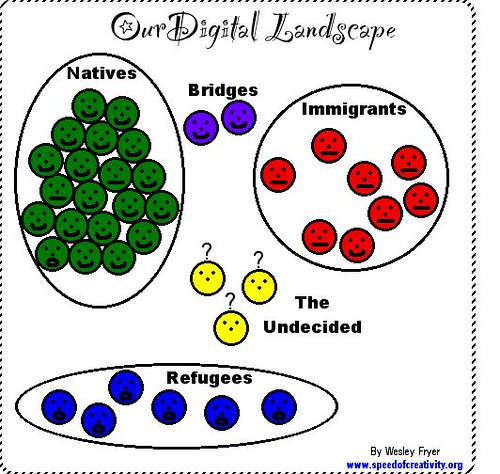An additional term may be needed, however, in addition to "native" and "immigrant." We may need to recognize the existence of some among us who fit better in the category of "digital refugee" rather than immigrant. At my podcasting workshop last Thursday for Tulsa Public Schools, librarian Barbara McCrary observed that many teachers may self-select the "refugee camp" instead of choosing immigrant status. I agree with her, and created the following graphic this evening to illustrate and expand further on this idea:

These groups may be definied in the following ways:
The Natives: Students who have and are growing up in the digital age, who assimilate digital tools and methods for communication as easily as they breathe.
The Immigrants: The older adults in society (and in our schools) who did not grow up with digital technology tools, but are working to "learn the language" and communicate effectively with the natives all around them. Some of the immigrants are open and accepting of "native ways," but many are resistant to change.
The Refugees: The older adults in society who have chosen to flee rather than integrate into the native culture. Digital refugees often feel lost in a threatening and dangerous environment, and perceive themselves to be homeless. They have chosen to flee rather than remain immigrants, and may actively work against the goals and interests of both the digital natives and the digital immigrants. The refugees are primarily motivated by fear and a staunch desire to not only resist change but actively oppose it, deny the existence of a changed environment, and/or ignore it.
The Bridges: The digital bridges are neither truly natives nor fully digital immigrants. Similar to millenials who have one foot in each century, the bridges have both native and immigrant traits. As a result, digital bridges are able to communicate relatively effectively with both groups.
The Undecided: These people have not made up their mind which group they fit in, or which group they want to fit in. They are likely immigrants or refugees, but may not have taken sufficient action to reveal their identities and/or preferences for group identity.
Do you know any "digital refugees?" I think many of the educators and leaders we term "laggards" may fit into this "digital refugee" camp more than they fit into the "digital immigrant" group. I do think their status in either of these two groups IS a choice.
David Warlick has challenged us to "stop acting like immigrants, and start acting like natives." What, however, are we supposed to do with the digital refugees in our midst- especially when they may comprise our school boards and many on our district administrative teams? What do you think?
Technorati Tags: k12online06 k12online